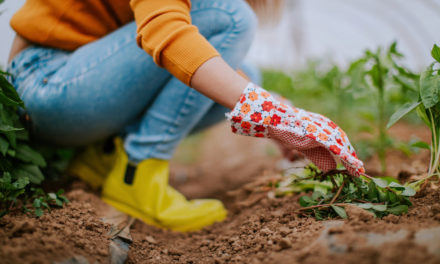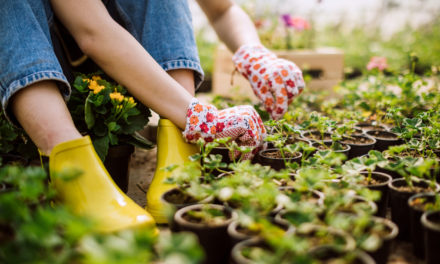Growing potatoes might seem slightly mysterious to a first-time back-yard gardener. But potatoes are an easy crop, and reaping the bountiful payoff is so much fun. It’s like searching for Easter eggs, only under the ground. And the root vegetable even grows in a variety of climates.
7 Easy Steps for Growing Potatoes
1. Prep Your Seed Potato
Cut the seed potatoes into chunky pieces, just making sure each piece has at least two good eyes. Note: Seed potatoes aren’t what you’ve got in your pantry. You’ll need to buy these.
2. Dry Your Seed Potatoes
Spread these chunks on a newspaper and let the cut surfaces dry for a day or two.
3. Plant Your Seed Potatoes
Plant them shallow, about 3 inches deep in soil that’s been worked with lots of compost or straw. Loose soil promotes lots of potatoes and makes them easy to dig when the time comes.
4. Keep Them Watered.
In about two weeks, green leaves will appear. When the stems get about 4 to 6 inches tall, take your hoe and pull dirt up around the plant, so only the leaves are sticking out. Or you can mound more straw or compost around the plants.
5. Protect and Wait.
Like all plants, potatoes take time to grow. Regularly hand-pick potato bugs and other insects from your growing plant.
6. Dig for Your Plants
Give them about two months, then dig under the plants with your hands to start looking for little new potatoes. Take note of where they’re at.
7. Harvest to Store
To harvest for storage, wait until the tops are completely dead. Then dig and store in a dark, cool cellar.
More Advice from the Experts
Cliff and Dottie Bennett have grown potatoes for more than 30 years.
“We like the Idaho-type potatoes,” Cliff said. “We’ve experimented with several different varieties – of course, there are hundreds of varieties – but we keep coming back to the white potatoes like Russet-Burbank.”
Classic whites are good to bake, boil or fry. They’re tasty in soups and hold up well in stews. “And they’re the ones Dottie likes,” Cliff added with a chuckle.
The Bennetts racked up major gardening experience in a Chicago suburb where Cliff was employed 35 years with United Airlines. Dottie worked 12 years as assistant manager for a credit union.
“We raised our three daughters on organic vegetables from our backyard garden,” Cliff said.
The couple retired to Nicholasville in 2004. They grow vegetables in beautiful beds that Cliff built, terraced in dry stone. They stair-step down the back yard to a creek at the bottom. The Bennetts kicked off their 2009 vegetable garden by planting five or six pounds of Kennebec potatoes bought at Fayette Seed.
Dottie said she couldn’t say that raising potatoes saved that much money, “But there’s nothing like potatoes right out of the ground. Who needs dessert if you have potatoes?”
“They are sweet and crisp. Really, just delicious,” Cliff added.
A couple of points about planting potatoes: They are one of the first vegetables you plant in the spring while the ground is still chilly. Use what’s called “seed potatoes” and not what you have in the pantry.
To prepare potatoes for planting, Ronniger Potato Farm in Maine recommends spreading them out on a crate or big piece of cardboard in the house where it’s warm – about 70 degrees – and in bright light in front of a window. Leave them for about four or five days. From the cluster of eyes on the potatoes, that warmth stimulates strong sprouts to grow. And with strong light, the sprouts remain short and stubby and are not easily broken off.

 Photo Credit: Ruth and Dave (Flickr)
Photo Credit: Ruth and Dave (Flickr) 



Comment on: 7 Easy Steps for Growing Potatoes